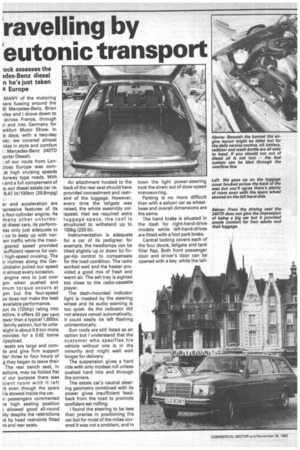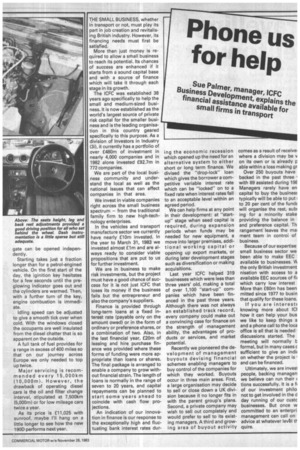ravelling by eutonic transport
Page 42

Page 43

If you've noticed an error in this article please click here to report it so we can fix it.
.ock assesses the ?des-Benz diesel n he's just taken S Europe
MANY of the motoring vere fussing around the 10 Mercedes-Benz, Brian !rley and I drove down to across France, through n and into Germany for ]nkfurt Motor Show. In 'e days, with a two-day ver, we covered almost iiles in style and comfort Mercedes-Benz 240TD )orter Diesel).
of our route from Lon:Joss Europe was cornat high cruising speeds torway type roads. With I and a full complement of e, our diesel estate car re9.47 lit/100km (29.8mpg)
er and acceleration are Ipressive features of its a four-cylinder engine. As many other unturbopd diesel cars, its performvas only just adequate to ! us to keep up with norwn traffic while the maxigeared speed provided sufficient reserve for con: high-speed cruising. The !r inclines along the Gerutobahn pulled our speed n almost every occasion. engine revs to just over pm when pushed and mum torque occurs at pm but the four-speed DX does not make the best available performance.
aut its (72bhp) rating into active, it offers 20 per cent ower than a typical 1,600cc family saloon, but its unlaeight is about 0.5 ton more provides for a 0.62 tonne /payload.
seats are large and cm-ride and give firm support 'ter three to four hours of g they began to leave their The rear bench seat, in ections, may be folded flat )r our purpose there was cient room with it left nt even though the spare I is stowed inside the car.
ir passengers commented le high seating position I allowed good all-round lity despite the restrictions !d by head restraints fitted nt and rear seats. An attachment hooked to the back of the rear seat should have provided concealment and restraint of the luggage. However, every time the tailgate was raised, the whole assembly collapsed. Had we required extra luggage space, the roof is structured to withstand up to 100kg (220 lb).
Instrumentation is adequate for a car of its pedigree; for example, the headlamps can be tilted slightly up or down by finger-tip control to compensate for the load condition. The radio worked well and the heater provided a good mix of fresh and warm air. The ash tray is sighted too close to the radio-cassette player.
The dash-mounted indicator light is masked by the steering wheel and its audio warning is too quiet. As the indicator did not always cancel automatically, it could easily be left flashing unintentionally.
Sun roofs are still listed as an option but I understand that the customer who specifies his vehicle without one is in the minority and might well wait longer for delivery.
The suspension gives a hard ride with only modest roll unless pushed hard into and through the corners.
The estate car's neutral steering geometry combined with its power gives insufficient feedback from the road to promote confident ear rolling.
I found the steering to be less than precise in positioning the car but for most of the miles covered it was not a problem, and in town the light power-steering took the strain out of slow-speed manoeuvring.
Parking is no more difficult than with a saloon car as wheelbase and overall dimensions are the same.
The hand brake is situated in the dash for right-hand-drive models while left-hand-drives are fitted with a foot park brake.
Central locking covers each of the four doors, tailgate and tank filler flap. Both front passenger door and driver's door can be opened with a key, while the tail
gate can be opened independently.
Starting takes just a fraction longer than for a petrol-engined vehicle. On the first start of the day, the iginition key hesitates for a few seconds until the preglowing indicator goes out and the cylinders are warmed. Then, with a further turn of the key, engine combustion is immediate.
Idling speed can be adjusted to give a smooth tick over when cold. With the windows closed the occupants are well insulated from the diesel chatter that is so apparent on the outside.
A full tank of fuel provides for a range in excess of 400 miles so that on our journey across Europe we only needed to top up twice.
Major servicing is recom mended every 1 5,0 0 0 km (1 0,0 0 0m). However, the drawback of operating diesel cars is the oil and filter change interval, stipulated at 7,500km (5,000m) or for low mileage cars twice a year.
As its price is £11,025 with sunroof, maybe I'll hang on a little longer to see how the new 190D performs next year.




























































































